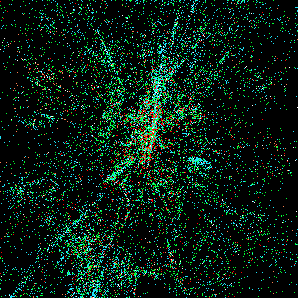The Local Universe
![]()

slower
STOP
PLAY
faster
load movie (enhanced structures)
identify clusters
![]()

slower
STOP
PLAY
faster
load movie (enhanced structures)
identify clusters
![]()
The movie above shows the distribution of galaxies in a box of (230 megalightyears)3 (assuming a Hubble constant of H0=70 km/s/Mpc) around our Milky Way.
Each point represents one galaxy of the CfA catalog of galaxies. The colours represent the type of each galaxy: Quasars and elliptical galaxies are shown in white, lenticular and S0 galaxies in blue, spiral galaxies in green, magellanic type and dwarf galaxies are shown in red.
Careful inspection of the data shows that elliptical galaxies are often found in clusters of galaxies whereas spiral and magellanic type galaxies show a more extended distribution.
The movie shows also a plane without galaxies. This is the "zone of avoidance", i.e. the plane of the Milky Way's disk, where dust absorbs the light of galaxies behind which makes the discovery difficult.
Watching the movie the eye can detect a lot of substructure in the distribution of galaxies. The centers of clusters of galaxies appear in the original data as radial extended "fingers". This is only an artifact of the method to measure the distances to galaxies: The measured radial velocity v0 is interpreted as caused by the "Hubble flow" which makes all galaxies escape from each other beacause of the expansion of the universe. The distance can then be derived using the formula D = v0/H0. In reality the velocities of the galaxies are influenced also by gravitational interaction between the galaxies and especially galaxies in clusters show a high velocity dispersion which makes a proper distance determination impossible using the method explained above.
But most of the large scale structure visible in the movie is real ! The galaxies are not uniformly distributed but in large filaments and superclusters.
The understanding of these large scale structure is a matter of ongoing debate and depends on the distribution of dark matter and the cosmological model.
The VIRGO consortium is a group of scientists who try to simulate the evolution of the universe and its large scale structure formation using supercomputers. Click here to get an mpeg movie which shows the evolution of a cluster in a simulation of the MPA Galaxy Formation Group.
(C) Sven Kohle